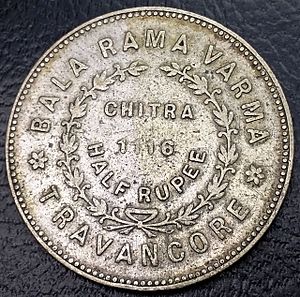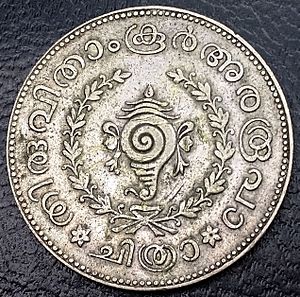Travancore Rupee facts for kids
The Travancore rupee was a special kind of money used a long time ago in a place called Travancore. This area is now part of the Indian state of Kerala. Travancore was once a "princely state," which means it was like a small kingdom with its own ruler, but it was also connected to the larger British Empire in India.
This rupee was a newer type of money compared to older coins used in Kerala, like Fanams, Achus, Chuckrams, and Kasu (also called Cash). The Travancore rupee was probably created to make trading easier with British India, especially for bigger deals.
The Travancore rupee was the highest value coin made for everyday use. Even though there were plans to make a 'One Travancore Rupee' coin, it never happened. The half-rupee and quarter-rupee coins were the highest values people could use.
These coins were made until 1946 CE (which was 1121 in the Malayalam Era). They stayed in use until 1949. After Travancore joined India, the Travancore rupee was replaced by the Indian rupee.
What Was Written on the Coins?
The Travancore rupee coins often had the names or symbols of the ruler in English on one side. The other side usually showed writing in the local language, Malayalam, along with Travancore's royal symbol. The Malayalam writing was usually a direct translation of what was on the front of the coin.
Understanding the Dates
When a year was printed on the coins, it was based on the Malayalam calendar. This calendar starts around 825 CE. So, to find the year a coin was made in our regular calendar, you just add 825 to the year shown on the coin.
For example, if a coin showed the year 1000, it was made in 1825 CE (1000 + 825 = 1825). The coins shown in the pictures have the year 1116. This means they were made in 1940 or 1941 (1116 + 825 = 1941).
How the Rupee Was Divided
Unlike the Indian Rupee used by the British and other Indian states, the Travancore rupee was divided differently. One Travancore rupee was equal to 7 Fanams. These Fanams were then divided into 4 Chakrams each. And each Chakram was made up of 16 Cash.
You can see how it worked in this table:
| Unit | How Many Smaller Units |
|---|---|
| 1 Travancore Rupee | 7 Fanams |
| 1 Fanam | 4 Chuckrams |
| 1 Chuckram | 16 Cash |
In the early 1900s, silver coins were made in values like the rupee and Chakrams. These included coins worth 2 chakrams, 4 chakrams, 1/4 rupee (which was 7 chakrams), and 1/2 rupee (which was 14 chakrams). The Cash coins, also called kashu, were usually made of copper. They came in values of 1 cash, 4 cash, and 8 cash.
The Travancore rupee also had an exchange rate with the British Indian rupee. This means you could trade one for the other. For example, 1 British Indian rupee was worth about 28 chakram and 8 cash of Travancore money.
See also



